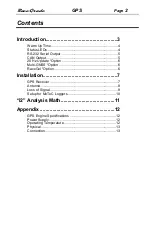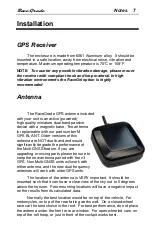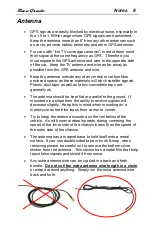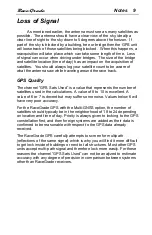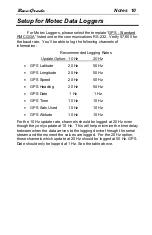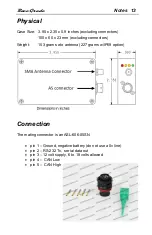
RaceGrade
GPS
Page
3
Introduction
Thank you for purchasing a
RaceGrade
v3 GPS
receiver.
This user’s
guide was written to help you understand how the
RaceGrade
v3
GPS
(Global Positioning System) device works. Please read it
thoroughly. Installation is very important and understanding how GPS
works will help you get the most from this sensor.
The RaceGrade v3 GPS
device uses a multiband GPS
specific antenna to track
satellites in orbit around Earth.
It takes a minimum of three
satellites to identify your position
on earth, and a fourth to
calculate accurate timing. Satellites are constantly moving, and a
satellite which the antenna sees at the start of an event might not be
visible minutes later. Satellites used in the GPS solution are dynamically
added or dropped based on signal quality. Ideally you should have 8 or
more satellites being tracked in order to obtain good accuracy. Anything
under 6 satellites is quite poor. With more satellites, there is more
information to correctly identify your position with less error. The key to
accuracy is your antenna having a clear, unobstructed line of sight to
the satellites in the sky.
The system uses a multi-frequency receiver to reference the
GPS, GLONASS, BeiDou, and Galileo constellations currently in
operation. Additionally, in certain parts of the world the GPS is able to
use up to three special geostationary satellites known as a Space
Based Augmentation System (SBAS). These satellites provide the
means to calculate DGPS (differential GPS) via reference station and
atmospheric modeling corrections.
The GPS system provides different levels of accuracy based on
where it is operated in the world. Without differential correction, you can
expect 8.2ft (2.5m) positional accuracy. When differential correction is
available, 95% of all data transmitted will be within 2.0ft (0.6m)
positional accuracy. Even more impressive is that up to 60% of all data
received with differential correction will have 1.0ft (0.3m) positional
accuracy. Satellite position and availability plays a large role in this
accuracy, so the more that are used in the position solution the better
chances you will have the higher accuracy in your position. This is why
the Multi-GNSS option is offered and strongly suggested for precision
oriented tasks.



